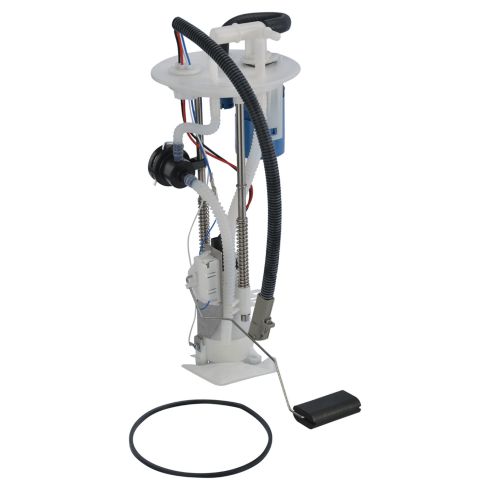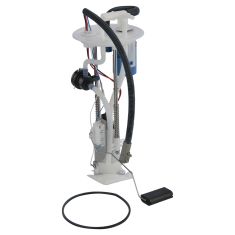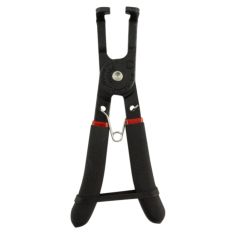1AFPU01086-Ford Ranger Fuel Pump Module Assembly TRQ FPA61983

Replaces
2002 Ford Ranger V6 4.0L Gas Engine with 112 in. Wheel Base Fuel Pump Module Assembly TRQ FPA61983

Frequently bought together
Product Reviews
Loading reviews
4.37/ 5.0
41
41 reviews
perfect easy replacement
August 23, 2017
Yes i would reccomend this replacement fuel pump for anyone with a Ranger needing to fix a fuel flow problem. the price was good and a direct fit mage it easy to change in a day,
Great product
December 2, 2017
Delivered earlier than estimated with no defects. I will shop here again!! The price was right! Thank you!
Fuel pump
January 20, 2018
Installed it as soon as I got it fits like a glove. Thanks 1aauto for fast delivery and accurate part.
Perfect fit
January 23, 2018
Great service ,Great Price ,Excellent shipping no problem,exact fit sales personal very knowledgeable
Fuel pump
April 13, 2018
i have had good luck with all the parts I gotten from you guys thanks and when I need more parts I will call you
2003 Ford Ranger Fuel Pump
May 14, 2018
Ordered and had it 2 days later. Was half the price of anywhere in town. Installed and worked great. Will look at 1aauto for other needs in the future.
Buy OEM - Do not buy this - Bad customer service
August 7, 2018
Bought to preemptively replace while doing other repairs. Installed part. 2 months later while in the middle of a big job for work, I could hear the pump making a funny noise one morning. Later that day I lost all fuel pressure while on the highway. Troubleshooted and pointed to the fuel pump. Left me stranded for 2 hours. Paid $130 for a tow home. Spent 5 hours reinstalling the original OEM fuel pump. Truck started right up with the old pump. Called their customer service for a refund or any kind of help. Instead was recited policy and offered only another junk replacement part that I don't need or want. Spoke with 2 different people, bad customer service, and no resolution. Junk part cost me at least $400 in lost wages/time/money. It's apparent that this company cares little about their customers. Do yourself a favor and don't give this company your hard earned money. Buy the OEM part.
Fuel Sending Unit
August 17, 2018
My 01 Ranger had a hard time taking gas and I narrowed the problem to the sending unit. Installation of the new unit was not bad (I took the bed off) and fixed my problem. 1A Auto customer service is A++. First unit they sent me was bad; shipped a new one at no cost and I didnt have to send the bad one back. Would recommend to anyone with the same problem.
Replaced Fuel Pump
December 22, 2018
I took my truck about 4 months ago to a mechanic because I had a gas leak at the fuel pump. Once I got it back I realized a couple days later my fuel gauge was broken. I couldn't prove they intentionally broke it so I did my research and thanks to your video and others on YouTube I convinced my Dad to help me replace it ourselves saving me well over $300.
I choose 1AAuto due to fast shipping and the good reviews found here. The Fuel Pump and Assembly arrived very quickly and we installed it today, took off the bed and had our neighbors help lift it off and on. The installation of the pump itself was SO very easy. The bed was the hardest part to get off but we managed. When we took the old pump off sure enough the sending arm was floating in the fuel. smh New Pump started immediately and the fuel gauge is fixed :)
fuel pump module
December 30, 2018
It got here really fast was able to get my truck back on the road and it is working great !!!!!!!!!
True drop in replacement
January 31, 2019
Ordered late Saturday night, shipped midday Sunday, received on Wednesday.
2 hours fighting bolts to remove the bed and 15 minutes to pull out and replace the fuel pump. Perfect fit on fuel lines and evap hoses, the electrical connector took a little wiggling. That might have been from 240k miles worth of crud under the truck though.
Im done with AZone and the rest. 1A is the best, great videos, awesome prices, quick shipping. Thanks 1A Auto!
Exactly right!
March 10, 2019
The part was just what I needed and it arrived just when I was told it would. Great job!
5 star
April 5, 2019
I've been purchasing parts for years from A1 Auto and they've always fit and been quality parts ;very happy Thanks Write
Ford ranger fuel pump
April 12, 2019
Pro: Same as the original. Even came with new gasket! Con: Delivery took six days ... still Love 1aauto, best price and best warranty!
Fuel pump kit
April 18, 2019
Great product, unbelievable price, only took 2 days to get it, easy installation, thanks, highly recommend it.
Will tell friends about this site.
April 29, 2019
Just as described and fit like OEM.
Fuel Pump
May 12, 2019
Amazing & fast delivery, wonderful quality
Great price and part
May 15, 2019
Price was well below local competitors and works fine.
Thanks A1!
Disappointing
May 23, 2019
This product did not work at all . Out of everything I ordered this was a terrible idea .I will never order any type of electronic part online . I had my truck in pieces and to my disappointment the part would not work . So I spent an additional 200.00 (on top of the 65.00 ) to get one from a local parts store .Didnt even bother to return the bad part it was a waist of my time .
Great product!
September 22, 2019
Works and fit great on my 2001 Ford Ranger XLT!
Truck works again!
January 6, 2020
Followed the viseo and everything works again! The video showed one of the connectors should be pulled out but in reality it was a push connector. Not a biggie but do tale a close look at yours!
Fits like a glove
July 1, 2020
Looks just the oem and fits like it too
A good replacement for my 2002 ranger edge
Mazda B3000 fuel pump
October 13, 2020
The pump was exactly what I ordered and fit like a glove. Came quickly
May 22, 2021
I ordered and received an OE quality part without the OE price and I received it a day early. When a fuel pump goes out it is not a good feeling but 1aauto made it as pleasearable as possible.
As described
May 23, 2021
The fit and function of this pump/sending unit is like the OEM that it replaced. The original one lasted 18 years and 186,000 miles; hoping this replacement does also.
Awesome Site
May 30, 2021
Very please with the fuel pump that was OEM quality and also pleased with the delivery and on time delivery as promised. Product was intact and in great condition thru shipping and resolved my problem as soon as it was installed. I highly recommend 1AAuto, as they state Quality Auto Parts and they stand behind their products and what they promise.
So Far So Good
June 14, 2021
Replaced original fuel pump with this at about 190k miles on my 2001 Ranger XLT. Starts right up every time. It might whine a bit louder than the last pump on that 1 second duration of priming itself when you turn your key to on, but maybe im just being paranoid. I really hope I did the right thing since the OEM part was like 3x more so I was a bit skeptical of the quality control on this pump, but 1Aauto seems to be a good brand and I look up to their youtube videos always and they seem to always say their parts are thoroughly tested and reliable, so I'm trusting them on it. I am pleased with it and will buy more of their products. I will report back if I have any problems.
Fixed hard starting ranger
August 17, 2021
Replaced the pump on a 2002 Ranger that was having hard starts. Worked perfectly to fix my problem, ranger starts easy and runs great.
Replacing pump, minimal mechanic ,Saved money
[{"url": "https://wac.edgecastcdn.net/001A39/prod/media/pNISJll75W64CYGsite/5f0454198013c4d9f71401eeba63c1f4_1637798551499_0.jpeg", "caption": "This way was easier, since my jacks were messed up \nClear shot"}, {"url": "https://wac.edgecastcdn.net/001A39/prod/media/pNISJll75W64CYGsite/1dad00c42601a51b04ad1e5068348ccd_1637798551499_1.jpeg", "caption": "Bed just moved back a bit"}, {"url": "https://wac.edgecastcdn.net/001A39/prod/media/pNISJll75W64CYGsite/a48cb4850523cfebddb8170ea4a37316_1637798551499_2.jpeg", "caption": "Had to remove bed liner to remove bed"}]
November 24, 2021
Right part sent to me, just a matter of installing it.
Since this pump was installed seems like my 137k 02 ranger has a lil more pep to the gas pedal.
Thank God, yall are on utube, all your info really helps.
Its all in the video
January 8, 2022
Thanks for the video it was very helpful and thats why I bought from you and continue to do so Thanks Adam
Buyer Beware!
January 19, 2022
Was the wrong electrical connection, wrong vent hose size, and left me hanging, out of gas because my gauge was reading a 1/4 tank but is was bone dry.
Fuel pump for a 2001 Ford Ranger.
April 3, 2022
It fit perfectly. The installation was good for a novice mechanic. Shipping was quick and the product was good.
No
July 1, 2022
Love 1a auto hate this part
Will be contacting 1a auto about this part.
Ordered this part to fix a long crank issue and to have a new pump. It didnt fix the issue because this part along with my other fuel pump were both the same
Meaning that the check valves in both assemblies are faulty. The faulty checks valve makes the fuel pressure intermittently accurate and inaccurate causeing hard to nearly NO start conditions. Once started the engine wont stall however this pump DOES NOT DO ITS JOB CORRECTLY for a 2001 FORD RANGER
Fuel pressure on psi gauge would drop in seconds of turning the key it was even hard for it to build the pressure and maintain it accurately the check valve In the system isnt correctly functioning
just byu the real fuel pump elsewhere!
Fast shipping excellent parts
October 11, 2022
Perfect fit, works great
(Not) guaranteed to fit
[{"url": "https://wac.edgecastcdn.net/001A39/prod/media/pNISJll75W64CYGsite/dadfe5df03eb5948a3b886a99ec4fef4_1665675023207_0.jpeg", "caption": "Whats on the replacement part"}, {"url": "https://wac.edgecastcdn.net/001A39/prod/media/pNISJll75W64CYGsite/71d99a31717da804c8219bae3adc6181_1665675023207_1.jpeg", "caption": "Whats on my 2003 Ford Ranger XLT"}]
October 13, 2022
Incorrect electronic connector size
December 13, 2022
Fuel pumps line connection sizes did not match existing.
March 14, 2023
did the job it works good
Great value
August 10, 2023
Fit my vehicle perfectly and all connections were just like the original fuel pump. No wiring alterations needed! Fantastic price too!
May 8, 2024
Went very will i used your video to install it For a 83ys man
May 10, 2024
Working so far.
Unsure how trusting I can be...
September 13, 2024
I'm not sure, still in a quandary to drive too far to test running performance, as I am not sure the internal check valve is holding fuel. Still having long cranking to start. And I've changed a lot of parts...this is my third fuel pump in 2 years.
Customer Q&A
What cost can I expect when I have this installed?
August 14, 2021
10
Prices vary depending on where you live. We recommend calling around to local reputable mechanics for a quote on services.
August 14, 2021
Cristina P
10
i installed my self. dropped tank to do so. major pain in rear. special ford connector clips break off bc you cant get at with proper tool. component from a1 auto does not come with them. ford wont sell without entire pump. next time if ever - i will cut a hole in bed of pickup like others i have done.
August 14, 2021
Russ G
10
This comes with a few other parts that I had installed. Total was $150.
August 16, 2021
Doug J
10
The shop quoted me over $600 for their pump installed. This one installed is easy as the beds on rangers come off with 6 bolts and a quick connect.
August 17, 2021
Tim W
Will it fit a Mazda b-4000 without me having to modified anything?
February 21, 2022
10
Be sure to verify all of the information shown in the Vehicle Fit tab before ordering. You will have to verify the year, make and model and any additional specs to verify the fit.
February 22, 2022
Cristina P
Ford is a registered trademark of Ford Motor Company. 1A Auto is not affiliated with or sponsored by Ford or Ford Motor Company.
See all trademarks.











